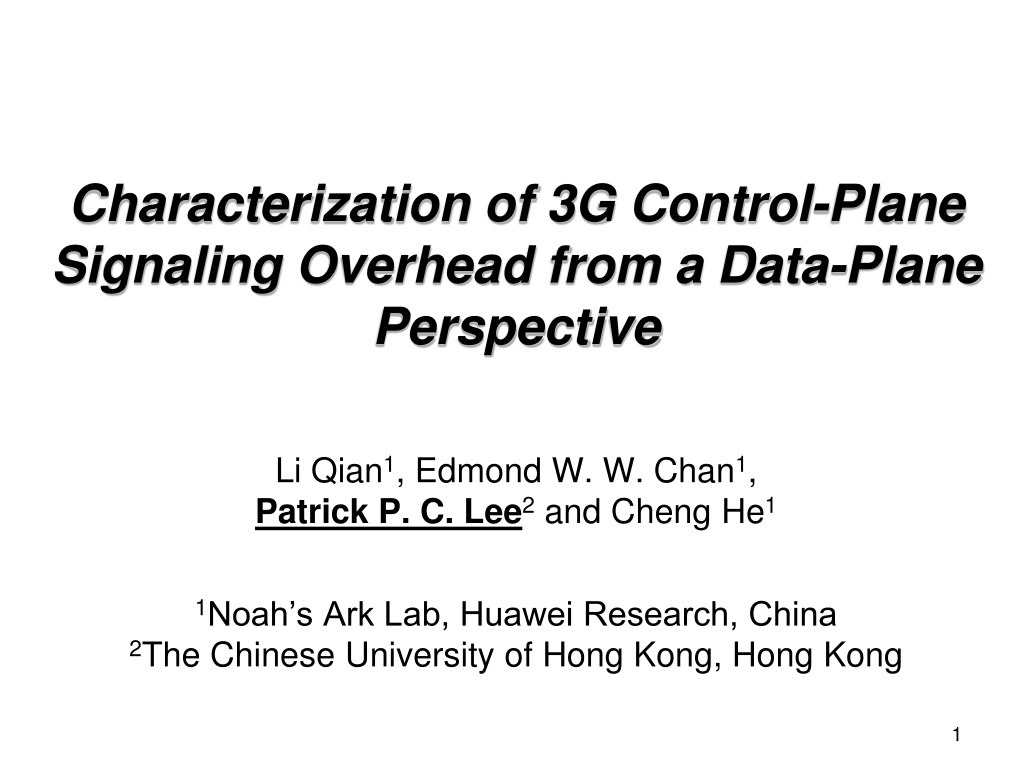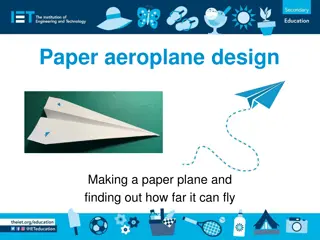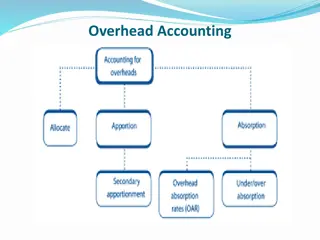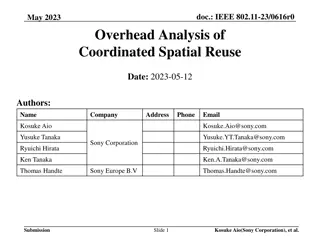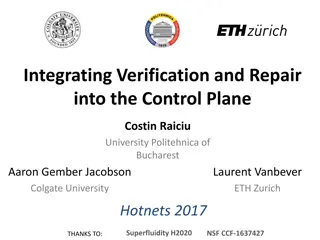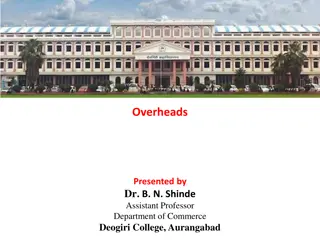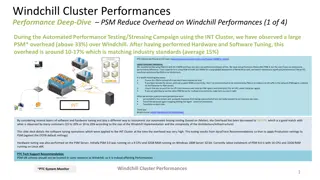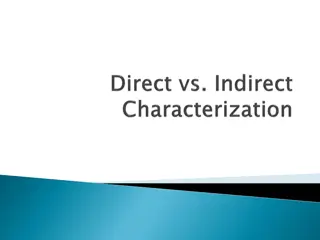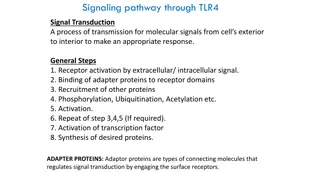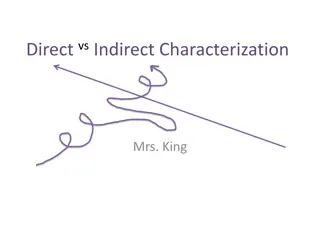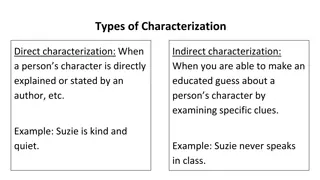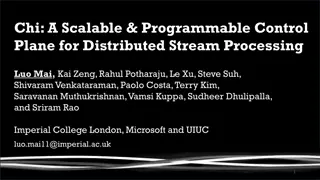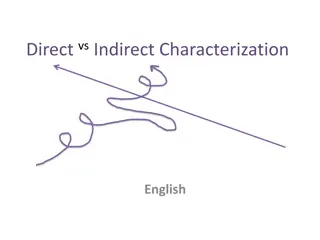Characterization of 3G Control-Plane Signaling Overhead
This study focuses on characterizing the control-plane signaling overhead in 3G networks caused by the initiation and release of radio resources with raw IP data packets. It explores the impact of massive signaling messages triggered by data transfer on 3G networks, aiming to validate a data-plane approach for signaling overhead inference. The research contributes to understanding the signaling loads induced by different transport protocols and network applications through extensive measurement studies.
Uploaded on Sep 27, 2024 | 1 Views
Download Presentation

Please find below an Image/Link to download the presentation.
The content on the website is provided AS IS for your information and personal use only. It may not be sold, licensed, or shared on other websites without obtaining consent from the author.If you encounter any issues during the download, it is possible that the publisher has removed the file from their server.
You are allowed to download the files provided on this website for personal or commercial use, subject to the condition that they are used lawfully. All files are the property of their respective owners.
The content on the website is provided AS IS for your information and personal use only. It may not be sold, licensed, or shared on other websites without obtaining consent from the author.
E N D
Presentation Transcript
Characterization of 3G Control-Plane Signaling Overhead from a Data-Plane Perspective Li Qian1, Edmond W. W. Chan1, Patrick P. C. Lee2 and Cheng He1 1Noah s Ark Lab, Huawei Research, China 2The Chinese University of Hong Kong, Hong Kong 1
Motivation Explosive growth of mobile devices and mobile application traffic Smart phone shipments forecast In million units 1.2billion <<Source: IDC, 2012>> <<Source: Cisco VNI Mobile, 2012>> Problem Massive signaling messages triggered by data transfer increase processing and management overheads within 3G networks. 2
Our Work Goal: To characterize 3G control-plane signaling overhead due to initiation/release of radio resources with only raw IP data packets Contributions: Using national 3G network traces/logs to validate a data-plane approach for control-plane signaling overhead inference First extensive measurement study of signaling loads induced by different transport protocols and network applications 3
Related Work Measurement studies of 3G network Round-trip times of TCP flow data (GPRS/UMTS network) [Kilpi_Networking2006] Compare similarity and difference with wireline data traffic (CDMA2000) [Ridoux_INFOCOMM2006] TCP performance and traffic anomalies (GPRS/UMTS network) [Ricciato_CoNext2005] [Alconze_Globecom2009] Control-plane performance of 3G network Signaling overhead from security perspective [Lee_computer networks2009] Infer RRC state transition from data-plane TCP traffic to quantify energy consumption [Qian_IMC2010] [Qian_ICNP2010] and application resource usage [Qian_Mobysis2011] 4
Related Work Data traffic behavior of different types of devices Compare handheld and non-handheld devices in campus WiFi network [Gember_PAM2011] Study smart phone traffic and differences of user behaviors based traces of individual devices [Falaki_IMC2010] 3GTest, a tool generate probe traffic to measure the 3G network performance [Huang_MobiSys2011] Study of data/control-plane performance of different mobile terminals [He_Networking2012] 5
3G UMTS Network Collect data/control-plane traffic from a commercial 3G UMTS network deployed in a metropolitan city in China Time span Nov 25-Dec1, 2010 Iu Total size 13TB SGSN Server RNC # packets 27.6 billion IP Bearer Internet R R router router Switch # flows 383 million GGSN Gn RNC Gi SGSN # devices 65K data/control plane traffic Iub RRC record logs # RRC records 168 million Analyze 24-hour IP packet traces collected on Dec 1, 2010 ~306M IP packets ~682K user equipment (UE) sessions Also obtain radio resource control (RRC) log files to validate our data-plane signaling profiling approach 6
RRC State Machine The RRC protocol associates with each UE session a state machine to control ratio bearer resources for data transfer. Two inactivity timers (TIDLE and TFACH)and service type govern state transitions. Each state transition triggers radio network controller (RNC) to exchange signaling messages with UE in the control plane. 7
3G Signaling Profiling Apply a data-planesignaling profiling method built on [Qian_IMC2010] and UMTS standard to study signaling load Simplify the complexities of correlating control-plane signaling messages and data-plane packets Extract all IP packets for each UE session and obtain the following data Inter-arrival times (IATs) of adjacent IP packets Application type of each packet Using a commercial DPI tool Transport-layer info (e.g., up/downlink, src/dst ports, TCP flag) of each TCP/UDP packet Uplink: from UE to remote destination Session service type (i.e., real-time or best- effort) Information extraction State transition inference Root cause analysis 8
3G Signaling Profiling Apply a data-planesignaling profiling method built on [Qian_IMC2010] and UMTS standard to study signaling load Simplify the complexities of correlating control-plane signaling messages and data-plane packets Apply IATs and session service type to the known RRC state machine and per- transition signaling message numbers to infer A sequence of state transitions Corresponding numbers of signaling messages Information extraction State transition inference Root cause analysis 9
3G Signaling Profiling Apply a data-planesignaling profiling method built on [Qian_IMC2010] and UMTS standard to study signaling load Simplify the complexities of correlating control-plane signaling messages and data-plane packets Identify the first IP packets right after one of the following three state transitions, and their application types/transport-layer info IDLE DCH (or I D) FACH DCH (or F D) DCH FACH (or D F) Ignore DCH IDLE and FACH IDLE which are only resulted from inactivity timer expiries Information extraction State transition inference Root cause analysis 10
Validation Ground truth: Measure number of RRC connection setups (Nsetup) from a 24-hour RRC log on Dec 1, 2010 Our signaling profiling method: Infer number of IDLE DCH states (NI2D) from IP packets in the same period Compute relative difference (NI2D-Nsetup)/Nsetup 11
Distribution of Signaling Messages IDLE DCH contributes >40% of the signaling messages. DCH IDLE and FACH IDLE altogether contribute only 18% of the total messages. 12
Effect of Payload Size 56.4% of all packets are small (<200B)and induce the most state transitions. Packets with zero-payload induce 23.9% of the transitions and are all TCP control messages (e.g., pure ACKs, SYN, RSTs, FINs). 13
Uplink (UL) vs. Downlink (DL) Packets Majority (>80%) of the transitions are induced from UL. I D contributes the most transitions and signaling messages for both UL and DL directions. 14
TCP vs. UDP Majority of packets that trigger state transitions are due to TCP from the UL direction. UDP traffic triggers only a small proportion (13%) of the transitions. 15
TCP Flag Analysis Top 8 types of TCP packets in each direction UL packets with SYN, FIN, or RST flags contribute a significant proportion of messages. Majority of their message are due to I D (not shown in the figure). 16
Application-Induced Signaling Loads Top 8 applications inducing the most signaling messages are all interactive applications, e.g., Web, Tunneling, Network Admin, and IM. SSL and HTTP in general introduce the most signaling messages from UL and DL, respectively. 17
Signaling-prone vs. Signaling- averse Applications Define signaling density =Ntrans/Npackets of each application Ntrans: Total # of induced transitions Npackets: Total # of packets Signaling-prone applications: large Signaling-averse applications: small 18
Signaling-Prone Applications SSL/QQ are signaling- prone in both DL and UL. Network admin applications like SSDP are signaling-prone on only UL. 19
Signaling-Averse Applications Bulk transfer applications, e.g., streaming, P2P, and file access,are signaling- averse on both directions. 20
Conclusions Show that the pure data-plane signaling profiling approach can accurately infer state transitions due to RRC connection setups Conduct the first comprehensive measurement in a city- wide 3G network to study the impact of raw data packets, transport protocols, and network applications on signaling loads Observe that most signaling messages are attributed to I D Possible solution: apply protocol/application-specific inactivity timers to avoid spurious RRC connection re-establishments 21
Q&A Thanks for your time 22
